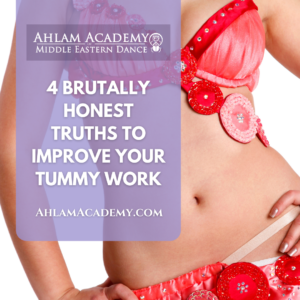In this article, I’ll be discussing a particular set of movements that frustrate so many dancers…
Tummy Work
I’ll be dishing out some brutally honest truths that will help those of you who struggle with these challenging, elusive movements.
I’ll be sharing some little-known, yet critical tips that will take your tummy work from tragic to magic.
Let’s get right to it!
It Takes Practice
No, seriously, way more practice. Once a week for a few minutes isn’t enough.
It takes a lot of time and effort to hone audience-pleasing, zhagareet-inducing belly skills.
But it’s so worth it!
In time, you can gain an amazing amount of control over your abdominal musculature, including your diaphragm.
All you have to do is practice [the right drills] EVERY DAY.
Within a few weeks, you should start seeing improvement.
Signs of Improvement would include:
- Faster movements that maintain clarity
- Smoother, more flowy movements
- Repetitive movements that endure for longer periods of time
- Achieving greater distance: your expansions/contractions go further
- Access more of your muscles: you are able to use more distal areas of your upper/lower abs
After several weeks, if you’re not seeing improvement, consider changing what drills you are using or challenging yourself more until you begin seeing results.
Size and Shape Do Matter
Let’s face it, not all bodies are shaped or sized for maximum tummy awesomeness.
It’s not so much a question of fat versus less fat, curvy versus straight.
It’s about the relative size and shape of your own body parts in relation to one another.
Here are 4 physical characteristics that can affect your tummy work:
- Length of “Usable” Tummy
For example, tummy rolls are going to look better, for longer, if you are working with a physically longer torso.
That’s the sad truth; I know because I’m short-waisted and my rolls just don’t have very far to go.😪 - The Shape and Size of Your Muscles
Helena Vlahos, the belly dancer featured on “That’s Incredible” back in the 1980s, became famous for rolling a line of 9 quarters up and down her tummy. This might not have been an achievable feat if she wasn’t blessed with a [relatively] wide, flat torso and rectus abdominus musculature that created ideal-sized skin folds to tuck and flip quarters. - Contrast Helps
Tummy work can look great on any size dancer, however, the amount of adipose tissue (fat) on different parts of the torso can help or hinder the “look” of particular movements.
Drawing on my experience as a NASM-certified personal trainer and fitness nutrition specialist, this is one of the tougher aspects of belly work to control.
You have two options here:
1) Reduce adipose tissue in a particular area, which despite what mass fitness marketers try to tell (SELL) to you, you can’t spot reduce fat, short of cosmetic procedures.
Anybody that tells you you can reduce fat on a specific area of the body with an exercise on that area of the body, is either lying or doesn’t know what they are talking about!
This is not how our body works. Our body doesn’t let us choose where it will take our fat tissue from.
2) You can build muscle in specific areas to “sculpt” a more tummy work-accentuating shape.
By sculpt, I mean, increase the size of the muscle underneath the adipose tissue and skin.
A great example of belly work-positive body sculpting is Denver-based dancer, Sadie. Her abs are the result of hypertrophy (increasing muscle size) training, which has resulted in full, luscious abs with well-defined lines along the obliques. - Smooth Skin
A frequently overlooked factor in the appearance of belly work is skin texture.
The more supple and smooth the skin, the more easily the skin is able to glide nicely over the moving muscles underneath.
My own tummy skin has a cellulite-like texture when I draw in my belly.
So, I tend to avoid showcasing my tummy movements to avoid drawing attention to this area of my body, unless I’m wearing a form-fitting costume that hides my skin but allows me to show off my belly movements.
While camouflaging my “imperfection” is my strategy of choice, some dancers opt for different skin-smoothing products or get cosmetic procedures to help improve their skin texture.
Posture
It might not seem like a big deal, but posture i.e. how you hold your body as you are executing your belly work either sets a beautiful stage to perform your tummy work or sets your hard work up for failure.
For example, when attempting a tummy flutter, instead of holding the usual dance posture, try sliding your ribs a little forward while sliding your pelvis back slightly.
This “ribs forward / hips back” configuration creates more contrast in the tummy area, so it’s not only easier to relax the abs, create a tummy vacuum, and move the diaphragm, but it’s actually easier to see (from your audience’s perspective).
Relaxing… In a Vacuum
Tummy flutters often feel like trying to pat your head, while rubbing your own tummy. It’s never easy trying to do more than two things at once.
Shimmying that belly takes a lot of breath and internal abdominal control.
While, at the same time, takes a lot of relaxation in the surrounding muscles.
Holding unnecessary tension can prevent the hard work your diaphragm is doing from being seen at all.
Would you like to learn some effective drills to improve your tummy skills?
In Ahlam Academy’s Tech, Drills & Zills classes, we practice various tummy work enhancing drills every week.
Practical tools that will improve your:
expansions/contractions
rolls
pops
flutters
We’ll also add some juicy, evocative tummy-based layers to jack up your undulations and hip movements.


